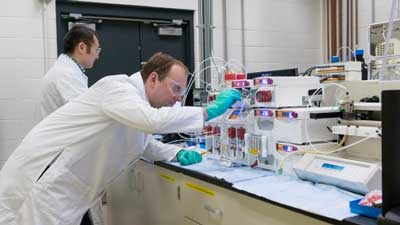| Nov 19, 2018 | |
Adapting continuous flow processing to complex nanomaterials to reduce manufacturing costs(Nanowerk News) Argonne ‘s Advanced Synthesis in Continuous Flow Reactor program applies powerful analysis and characterization tools to understand processes at the atomic level to advance manufacturing of fine chemicals and nanosized materials. |
|
| Businesses often struggle to produce fine materials and nanomaterials at commercial scales. The U.S. Department of Energy’s (DOE) Argonne National Laboratory, long a leader in chemical process scale-up research for advanced materials, recently invested in new capabilities to address this challenge. Known as Continuous Flow Reactors (CFR), the technology can dramatically improve the consistency and efficiency of manufacturing the materials used in a wide range of applications. | |
 |
|
| Argonne’s Continuous Flow Reactor can dramatically improve the consistency and efficiency of manufacturing advanced materials. (Image: Argonne National Laboratory.) | |
| In today’s fine-materials manufacturing environment, chemical producers primarily rely on batch reaction processes, which create industrial chemicals in tanks heated to a predetermined temperature; once the process is complete, the reaction must stop for emptying the tank and replenishing the precursors. This involves a lot of starting and stopping that is labor-intensive and inefficient, and can result in batch-to-batch inconsistencies that are not acceptable in a production environment. | |
| By contrast, CFR processing eliminates the batch-to-batch variability. The material is produced continuously in the same reactor and using the same process parameters. There is no need to stop the process to empty and recharge the reaction vessel. The amount of material produced depends not on the tank size and number of batches, but on the time and the flow rates at which the continuous process is run. | |
| According to Argonne Principal Investigator Kris Pupek, “Beyond the consistency improvements, CFR can streamline production of fine chemicals by permitting rapid optimization of process parameters such as temperature, flow rates, ratio of reagents and other parameters. While CFR can’t be used for all chemical production processes, it’s well suited to producing not only fine organic materials such as advanced electrolyte additives, but also materials such as catalysts and nanoparticles. Because the microfluidic plates used for chemical reactions are transparent, we can see into the reaction process as it occurs using tools such as the high-energy X-ray beams at the Advanced Photon Source, a DOE Office of Science User Facility at Argonne, in order to understand what’s happening at incredibly fine time and resolution scales, which is particularly important for understanding processes governing nanosized material production.” | |
| The Continuous Flow Reactor program is located at Argonne’s Materials Engineering Research Facility (MERF) outside Chicago. Researchers at the MERF can apply Argonne’s CFR capabilities to produce samples at pre-pilot-scale rates up to 100 grams of a single material. Pupek anticipates that they will be able to create specifications for highly efficient, custom microfluidic plates tailored to run specific chemistry. The custom microfluidic reactors can be used for many of the commercially available CFR systems. The program is also expected to develop highly customized processes using Argonne-designed systems that are not available commercially today. | |
| Argonne’s world-class in-situ diagnostics, characterization, computer modeling, scale-up technology and expertise in chemical and materials sciences support a wide range of research needs. Taken together, these capabilities enable the MERF to pursue process research and engineering advances that might not be possible in other environments, which is the driving force behind the laboratory’s Manufacturing Science and Engineering initiative. | |
| Although CFR facilities exist at other locations in the United States, Argonne is one of the first U.S. institutions to offer the breadth and depth of simultaneous in situ and operando characterization, simulation modeling and optimization capabilities to support process innovation. One example of this breadth is Pupek’s collaboration with computing researchers to develop new algorithms for robust optimization of CFR-synthesized materials. | |
| “The CFR setup at MERF is ideally suited for using active learning and optimization techniques to automate the navigation of the large parameter space and to deliver targeted nanoparticle properties,” said Stefan Wild, a computational mathematician at Argonne. |
| Source: Argonne National Laboratory | |
|
Subscribe to a free copy of one of our daily Nanowerk Newsletter Email Digests with a compilation of all of the day's news. |
